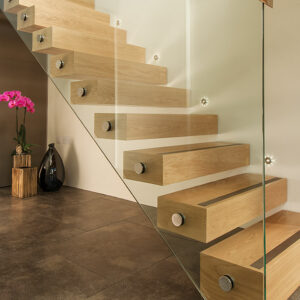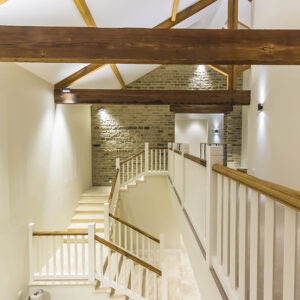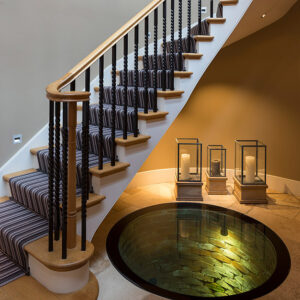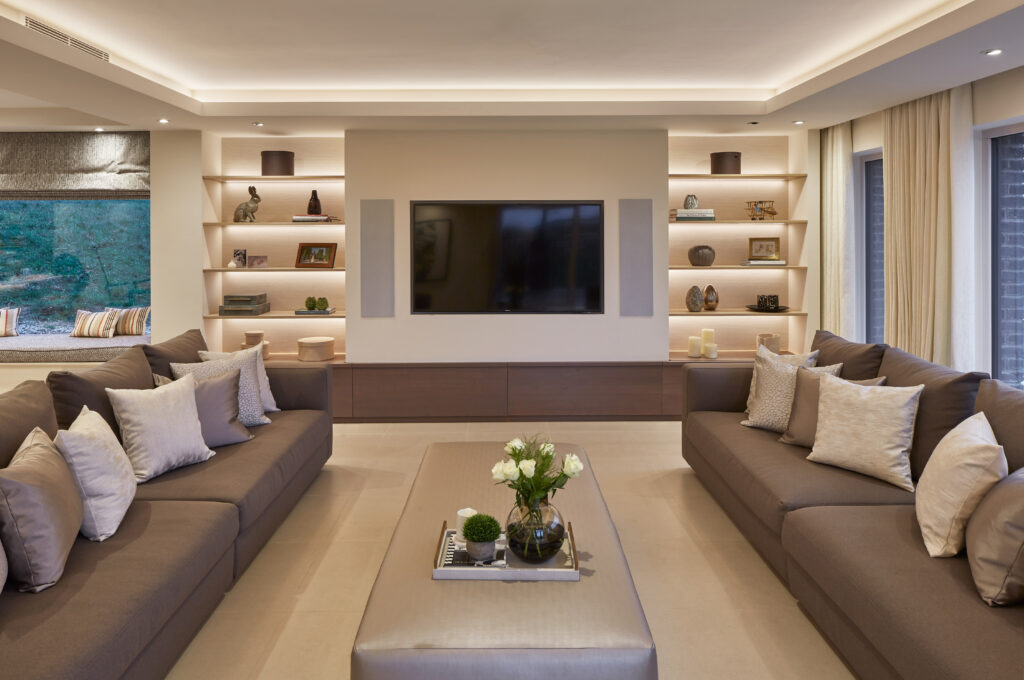Reinvent even a modest space with the help of imaginative stair lights
Staircases often don’t get a lot of focus when people are lighting buildings, but they can provide an amazing opportunity to alter the mood of a home by adding effects that could be too much for a living room but perfect for a transient space. Stairs come in many forms such as freestanding, architectural, timber, metal and sculptured. A staircase often sets the scene between rooms so it needs to have effective lighting for safety but also it will create a seamless transition from one space to another so you shouldn’t have a blinding bright light in the hall as this could ruin the mood/tone of the house.
The style of the home will also be need to taken into consideration when adding lighting because stairs can be situated in different areas of the house so will need to be lit differently. In addition, you will need to consider if there are any features on the stairs like pictures or paintings as you might want to highlight these items. All together you want to make sure your stairwell blends in with all the different rooms about the house and will provide effective lighting to be able to move about between rooms as well as highlight any features the homeowner wants.

Individual stair lighting
A way you can light up a staircase is with individual stair lights, this method can be subtle or be exaggerated. This method is where you put a light on every step or every other step. When the light is on you want it directed onto the step so it leaves a subtle glow to illuminate them. One way you can do this is by having a light with a half-eyelid so the light is directly focused at a certain angle. Some products we offer that can be used are the ML01 or LEDLYTE. When the stairway is narrow the best light you could use would be a 1W stair light, this is so it doesn’t overpower the area but it still leaves a good spread of light against the step. In addition, there would be no glare and the light would reflect off the opposite wall making the space look more open. If you were to use a 1W wall light it would be impractical as it would make the area look smaller and wouldn’t provide a satisfactory look in the house.
Linear lighting
Another way to light a staircase is to use linear lighting. This is a method that uses downlights or uplights to create a look of the stairs floating. Normally, linear lighting can be easily covered by using a hand railing, but you can have then showing. When leaving the LED showing you would need to factor in the glare coming from the light as well as the look of it. If you wanted the lighting to be recessed under the stairs the best lighting you could choose is an LED strip this is because it is flexible and you can have an opal diffuser on the light to make it a softer shadow. In addition, with the diffusers you would be hiding the small LED dots because they can create an unwanted shadow. Both solutions are good ideas and will make the space seem larger as the eye will focus on the walls behind the stairs.

Decorative lighting
An alternative method that can be used is to light your stairs is by using decorative lighting. Often, a lantern is used on each landing, along with wall lights on the stairs, to provide light to all of the features of the building that surround the stairs, as well as the staircase itself. In an open area, it is normally difficult to bring the lights closer to the stairs, so the solution for this type of stairwell would be to suspense lanterns in the centre of the void linking each one to the net so that combined they would be able to provide a layering of light to each stairwell. If you have a staircase that changes sizes in an open stairwell you could add some individual lanterns to each area this is so that it will have the same impact as if you were hanging goblets and all features can be lit up.
Skylights
Sometimes you will have skylights. These can be used at the top of staircases to introduce natural light to the centre of the house. In the daytime, the skylights are highly effective but once it is night the area will become dark in that area. A solution would be to use an LED strip to create a band of light around the skylight, or you could use small spotlights, like the MF02 or MS02.

Underside lighting
Another feature of the stairs we should consider is the underside this is because sometimes there is an open area under the stairs, which can be used to create a feeling of space using lighting. In addition, individual recessed uplights could be used to bring life to an area that is normally forgotten about. These solutions will draw attention to the wall and make the hall seem larger and more spacious.
Overall, there are many different light features you can consider when lighting a stairwell. Some elements you will need to make sure you take into consideration when you are designing/choosing your lighting are height, width, painting or picture, material, and positioning. The challenges that lighting designers and homeowners face are that there is a variety of lighting fixtures and techniques available, so knowing the impression you want the room to give off as well as what lighting would be appropriate to effectively light the area is crucial to determine at the start of the project.



